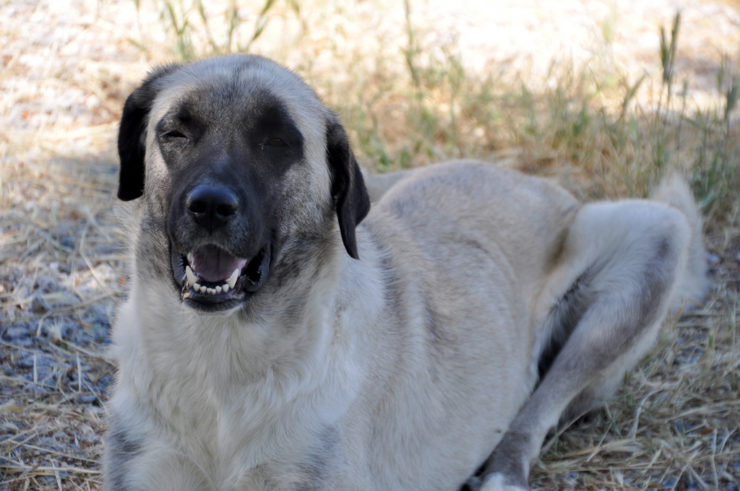Q: Is it true that the Kangal Dog Breed has the strongest bite force out of all Domestic Dog Breeds?
I read something about this domestic Dog breed, the Turkish Kangal, there was a Kangal from the Sivas Line that had a bite force of 743lbs (!), and they said that some larger dogs have the same bite force if not more than that of a wolf. Is this true?
Answers and Views:
Answer by WolfHaunt
Mastiff breeds tend to have the strongest bite force of all domestic dog breeds because they have huge, square jaws and heads, and are big animals. However, I do not know if that bite force for a Kangal is correct… It depends on the dog. A protection dog will have a better bite force than a couch potato dog.

Photo Credit: Panegyrics of Granovetter/Flickr CC
I, however, do not believe they are all about stronger in bite than a wolf. A good-sized wolf with a similar size to a Kangal can have a DEFENSIVE bite that's almost 500lb. Now, there was a Mastiff that had a full bite force of around 500lb, however, if I remember right, this Mastiff was not one of the biggest Mastiffs around.
I think that if that Kangal bite force reading is correct then that dog was probably RIGOROUSLY trained in protection or some other bite competition.
But, I say that perhaps a Kangal can have a similar bite force to a wolf, but honestly, I don't know.
Answer by Winston
A Kangal's bite force is measured at 750 pounds per square inch, which is more than double the strength of a German Shepherd and 6 times stronger than a human being.
They have powerful jaw muscles and strong neck muscles to support their power.
The Kangal also has a very wide mouth with many teeth, so they can grab large objects and carry them in their mouth with ease.

Answer by Brian
I raise Kangal and their larger cousin Guregh Malakli or Boz. Never measured bite force. But have spoken to Turks that have. Seen videos of them dominating almost every breed, wolves, boar. If Kangal is usually said to have 743 psi, the Guregh Malakli would be more. They are 33-42" 160-260#.
Answer by PlayerHater8806
I don't know about Malakli bite force but I doubt the Kangal has a stronger bite force than that of a gray wolf. In that, I do not believe but having an equal bite force to that of a wolf, that I can believe.
Answer by Ned
Kangal dogs are known for their incredible bite force, and the Turkish Kangal is one of the most powerful dog breeds. They have a reputation as livestock guardians and are used to protect sheep, cattle, and goats from predators such as wolves. They were also bred to be fighting dogs in the past.
The bite force of this dog has been measured at up to 800 pounds per square inch (psi)!
Answer by David
No wolf in the world has a bite force even close to any dog in the mastiff family, especially the Kangal breeds.
The Kangal actually doesn’t have the highest bite force anymore. The new leader in this field goes to the BOZ Shepard that is often mistaken for the Kangal but had a much more massive head and jaws.
Answer by Bonzie12
At 556 PSI, the bite force of mastiffs is the most powerful of all the breeds tested.
(National Geographic findings and testing results)
Answer by Griffing
There is a video of a Sarplaninac dog killing two wolves.
The Sarplaninac doesn't settle for running off these wolves but takes them down.

Renowned for his incorruptible courage, the Sarplaninac will not hesitate to lay down his own life in defense of family, flock, or master. The Sarplaninac is a peerless flock guardian and family protector with an undiluted spirit and a noble heart. These are the characteristics that have also made the Sarplaninac a valuable service dog with a number of K9 units within the countries that now comprise the Former Yugoslavia.
- Are Kangal Dogs Illegal in the US?
- Where in the USA can I buy a Kangal Dog?
- Is the Kangal dog breed Turkish or Kurdish?
Some herder/guard dogs may or may not have the strongest bite force, but can sometimes more than compensate by their ferocious and aggressive spirit.
So, should it be bite force or reputation for a skilled and successful attack/defense that determines the selection of a guard dog?
Know better? Give your own answer to this question!
Thomas Crabtree says
Kangal 735 psi
Ross says
The Kangal has the most powerful bite force of any domesticated dog in the world, the Hyena has the most powerful of all K9’s.
merv dudgeon says
hyena is not from the canine family they are from the cat family, wolves come from that family hence why you can cross them with domestic dogs, the hyena can’t be crossed with a wolf or dog. The Giant hyena has a bite force of over 1000 lbs about the same as predicted as epicyon haydeni the largest prehistoric dog which was about the size of a lioness. If you want the animal with the most bite force buy a crocodile but it may have you for dinner one day apart from the guy on you tube “the man who swims with crocodiles”
Clay Blevins says
Umm your wrong as well. Hyena is part of neather k9 or cat families. They are actually part of the Hyaenidae family in which there are only four distinct breeds in this family.
PlayerHater8806 says
The comment has been moved into the body of the post.
David says
The comment has been moved into the body of the post.
Skipper... says
They have not found a completely accurate way of testing bite force in dogs for several reasons. Breed, training of individual dog and their reason for biting. An 80lb dog who has been trained for 'protection' work is going to be more formidable than an 80lb dog of the same breed who is a couch potato.
So bite per bite ~ that would sole depend on the dog, the situation and the intent of the bite…
David says
That is entirely false.
introvertedguy06 says
that is very hard to believe, I don't think it is accurate
lizanne t says
never heard of this breed now im going to have to look it up